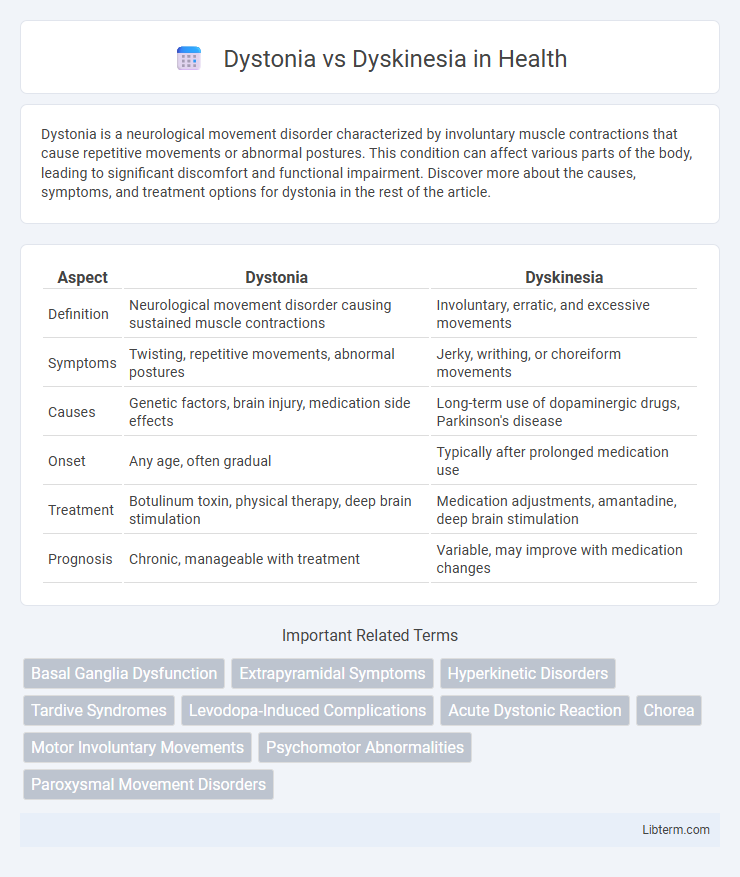Dystonia is a neurological movement disorder characterized by involuntary muscle contractions that cause repetitive movements or abnormal postures. This condition can affect various parts of the body, leading to significant discomfort and functional impairment. Discover more about the causes, symptoms, and treatment options for dystonia in the rest of the article.
Table of Comparison
| Aspect | Dystonia | Dyskinesia |
|---|---|---|
| Definition | Neurological movement disorder causing sustained muscle contractions | Involuntary, erratic, and excessive movements |
| Symptoms | Twisting, repetitive movements, abnormal postures | Jerky, writhing, or choreiform movements |
| Causes | Genetic factors, brain injury, medication side effects | Long-term use of dopaminergic drugs, Parkinson's disease |
| Onset | Any age, often gradual | Typically after prolonged medication use |
| Treatment | Botulinum toxin, physical therapy, deep brain stimulation | Medication adjustments, amantadine, deep brain stimulation |
| Prognosis | Chronic, manageable with treatment | Variable, may improve with medication changes |
Introduction to Dystonia and Dyskinesia
Dystonia is a neurological movement disorder characterized by involuntary muscle contractions causing repetitive movements or abnormal postures, often resulting from dysfunction in the basal ganglia. Dyskinesia refers to a group of hyperkinetic movement disorders involving uncontrollable, excessive movements, commonly emerging as side effects of long-term dopamine replacement therapy in Parkinson's disease patients. Both conditions affect motor control but differ in patterns of muscle activity and underlying pathophysiology.
Defining Dystonia: Symptoms and Types
Dystonia is a neurological movement disorder characterized by involuntary muscle contractions that cause repetitive twisting, abnormal postures, or sustained movements, often leading to pain and functional impairment. Symptoms of dystonia include muscle cramps, tremors, and spasms that affect various body parts such as the neck (cervical dystonia), eyelids (blepharospasm), or limbs (focal dystonia). Types of dystonia range from focal, segmental, generalized, to hemidystonia, each classified based on the affected region and underlying causes, distinguishing it from dyskinesia, which primarily involves involuntary, erratic, and often jerky movements.
Understanding Dyskinesia: Key Characteristics
Dyskinesia is characterized by involuntary, erratic, and often repetitive movements that can affect various body parts, commonly seen as a side effect of long-term Parkinson's disease treatment with levodopa. Unlike dystonia, which involves sustained muscle contractions causing twisting and abnormal postures, dyskinesia manifests as more fluid and irregular motions such as chorea or athetosis. Understanding these key characteristics helps in differentiating dyskinesia from dystonia, facilitating accurate diagnosis and targeted management strategies in neurological practice.
Causes and Risk Factors of Dystonia
Dystonia primarily results from genetic mutations affecting nerve pathways involved in muscle control, with mutations in the TOR1A gene being a common cause. Environmental factors such as trauma, infections, or exposure to certain medications like antipsychotics can increase the risk of developing secondary dystonia. Unlike dyskinesia, which often arises as a side effect of long-term dopaminergic treatment in Parkinson's disease, dystonia's etiology is more closely linked to abnormal brain signaling in the basal ganglia and associated structures.
Underlying Triggers for Dyskinesia
Dyskinesia is primarily triggered by long-term use of dopaminergic medications, especially in Parkinson's disease patients, causing abnormal involuntary movements due to fluctuating dopamine levels. Other underlying triggers include overstimulation of dopamine receptors and neurochemical imbalances in the basal ganglia. Unlike dystonia, which often results from genetic mutations or brain injury affecting muscle contractions, dyskinesia is closely linked to medication-induced alterations in motor control pathways.
Comparing Symptoms: Dystonia vs Dyskinesia
Dystonia presents with sustained, involuntary muscle contractions causing twisting and repetitive movements or abnormal postures, often affecting specific body parts such as the neck, hands, or eyelids. Dyskinesia involves rapid, irregular, and uncontrolled movements that can include chorea, athetosis, or dystonic-like posturing, commonly seen as a side effect of long-term Parkinson's disease treatment. Unlike dystonia's sustained muscle contractions, dyskinesia symptoms are more fluctuating and typically correlate with medication cycles.
Diagnostic Approaches and Tools
Diagnostic approaches for dystonia primarily involve clinical assessment and electromyography (EMG) to identify sustained muscle contractions and abnormal postures, while dyskinesia diagnosis relies on detailed movement observation and patient history to detect involuntary, irregular, and purposeless movements. Advanced imaging techniques such as MRI and functional MRI assist in ruling out structural brain abnormalities for both conditions, with dopaminergic challenge tests and video recording analysis often employed to distinguish between dystonia and dyskinesia. Genetic testing and neurophysiological studies enhance diagnostic accuracy by identifying specific biomarkers and patterns unique to each movement disorder.
Treatment Options for Dystonia
Treatment options for dystonia include botulinum toxin injections, which target specific muscles to reduce involuntary contractions and improve motor function. Oral medications such as anticholinergics, muscle relaxants, and benzodiazepines can alleviate symptoms by modulating neurotransmitter activity in the central nervous system. In severe or medication-resistant cases, deep brain stimulation (DBS) targeting the globus pallidus internus has shown efficacy in reducing dystonic movements and enhancing quality of life.
Managing Dyskinesia: Current Therapies
Managing dyskinesia involves a combination of pharmacological and non-pharmacological therapies aimed at reducing involuntary movements. Levodopa-induced dyskinesia is commonly treated with adjustments in dopaminergic medications, including the use of amantadine, which shows efficacy in reducing symptoms. Deep brain stimulation and physical therapy also play crucial roles in improving motor control and patient quality of life.
Prognosis and Quality of Life Considerations
Dystonia often results in sustained muscle contractions causing abnormal postures, with prognosis varying based on type and treatment response, sometimes leading to progressive disability impacting quality of life. Dyskinesia, characterized by involuntary, fluctuating movements often linked to Parkinson's disease or medication effects, may improve with tailored therapy but can significantly impair daily functioning and social interaction. Both conditions require individualized management strategies to optimize symptom control and enhance long-term quality of life outcomes.
Dystonia Infographic

 libterm.com
libterm.com